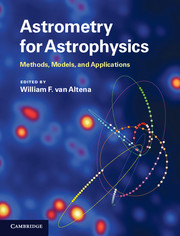Book contents
- Frontmatter
- Contents
- List of contributors
- List of acronyms
- Preface
- Part I Astrometry in the twenty-first century
- Part II Foundations of astrometry and celestial mechanics
- 4 Vectors in astrometry: an introduction
- 5 Relativistic foundations of astrometry and celestial mechanics
- 6 Celestial mechanics of the N-body problem
- 7 Celestial coordinate systems and positions
- 8 Fundamental algorithms for celestial coordinate systems and positions
- Part III Observing through the atmosphere
- Part IV From detected photons to the celestial sphere
- Part V Applications of astrometry to topics in astrophysics
- Index
- References
7 - Celestial coordinate systems and positions
from Part II - Foundations of astrometry and celestial mechanics
Published online by Cambridge University Press: 05 December 2012
- Frontmatter
- Contents
- List of contributors
- List of acronyms
- Preface
- Part I Astrometry in the twenty-first century
- Part II Foundations of astrometry and celestial mechanics
- 4 Vectors in astrometry: an introduction
- 5 Relativistic foundations of astrometry and celestial mechanics
- 6 Celestial mechanics of the N-body problem
- 7 Celestial coordinate systems and positions
- 8 Fundamental algorithms for celestial coordinate systems and positions
- Part III Observing through the atmosphere
- Part IV From detected photons to the celestial sphere
- Part V Applications of astrometry to topics in astrophysics
- Index
- References
Summary
Introduction
Astrometry of celestial objects is based on the determination and use of the coordinates of these objects with respect to appropriate space and time reference systems. Such coordinates are essential for many applications in astronomy and geodesy. This chapter provides the theoretical basis and definitions, as well as expressions to be used for applications related to this field. The astrometry textbooks by Green (1985) and Kovalevsky and Seidelmann (2004) are also useful references. Details on the corresponding algorithms can be found in Chapter 8.
Definitions
Coordinates of a celestial object
The coordinates of celestial objects and their time variations are required for expressing the positions and motions of celestial bodies, which are essential for the interpretation of astronomical observations in terms of physical and dynamical characteristics of the Universe. Those coordinates are used for Galactic and Solar System astrometry (optical and radio astrometry), for geodesy, celestial mechanics, astrophysics, and cosmology. The distance of a celestial object is accessible to direct measurement only for Solar System objects which can be observed by telemetry observations (e.g. with radar, laser ranging, etc.). An indirect way to access the distances of nearby celestial objects is the determination of their annual and/or diurnal parallaxes (see Section 7.2.4 and Chapter 22). When the distance is not considered, the “position” of a celestial object (also called “place”), as well as its “coordinates,” will refer here to the apparent direction in which that object is seen from the observer, which can be represented by the unit vector in that direction.
- Type
- Chapter
- Information
- Astrometry for AstrophysicsMethods, Models, and Applications, pp. 93 - 111Publisher: Cambridge University PressPrint publication year: 2012



